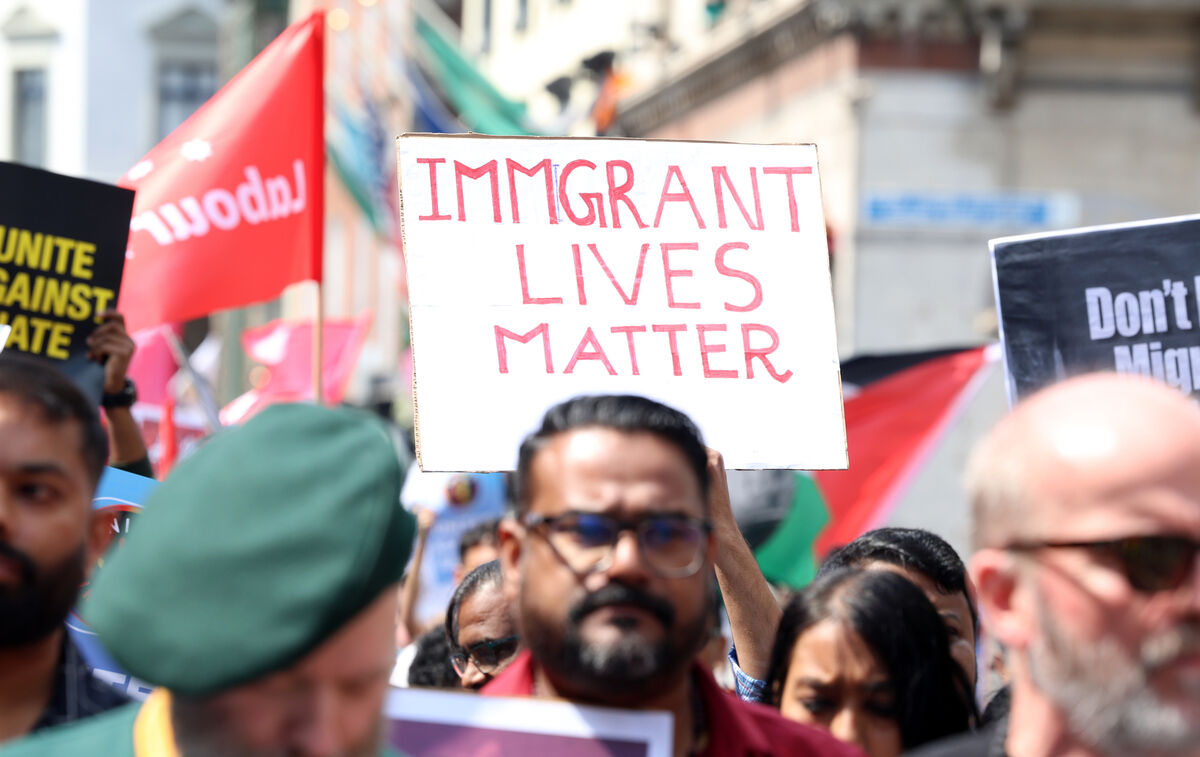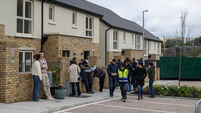Ireland’s history of humiliating the powerless has a new chapter

Protesters march in July to the Dáil to protest against an assault on an Indian national in Tallaght. 'Irrespective of its colonial past, Ireland, like any responsible nation, has the obligation to protect at least those who live here already, if not those who come to its shores seeking asylum.' File photo: Leah Farrell/© RollingNews.ie
Ireland’s history as a colonised nation and the comfortable centrist narrative that “you can’t be racist and Irish” has created a culture of denial around racism and racist acts which is seriously damaging to the lives of migrants here.
As our politicians get ready to return to the Dáil, this issue should be front and centre as it threatens to cause irreparable damage.
In his book, , journalist Derek Scally wrote that there was a “heart of denial at the heart of Irish society” that allows for “the cascade of the humiliations of the powerless.” He argues that this tendency of cover-up and denial of clerical abuse will simply find new outlets, and it seems migrants are the latest group to fall victim to this culture.
Recently ran an article on how there is "no statistical indication of a rising threat to Indians". Relying on Garda sources, the piece reported that despite recent "high-profile" attacks, there is no real increase of hate crimes committed on the Indian community.
Reports carried in the Indian media may therefore be exaggerating the danger posed to the community. Shortly after, right wing agitator Mick O’Keefe, who is well known for spreading racial hatred on the internet, highlighted the “no statistical threat to Indians exist” bit on X and observed that the article shows how the attacks on Indians were “one big lie”.
In the hundreds of comments with racial slurs under the post there was a common theme: these lying Indians are playing the ‘victim card’ while they are the ones harming Irish women and children.

This denial of the reality of racism in Ireland is not new. In 1964, a Nigerian student was attacked by a gang of youths in Dublin city, losing an eye. When the Nigerian community then came forward with other instances of violence, senior politicians, newspapers columnists and religious leaders denied racism.
Writing for , the then Minister for Justice Charles Haughey wrote that these reports are “grossly exaggerated”, and it is “ridiculous” to say there is racial violence in Ireland.
In 2002, a Chinese student was attacked and killed by a gang of teens while out for a walk in Beaumont. Dave McInerney, Sergeant in charge of the Garda Racial and Intercultural office at the time, recounts how he attempted to reassure the Chinese community “that this was an isolated case, not typical in Ireland”.
When Dublin Circuit Criminal Court found five youths guilty of manslaughter, four of them received suspended sentences and were released. The fifth youth who struck and killed the victim received a sentence of four years due to his tender age of 18, and no reference was made to the racial nature of the crime.
In his doctoral dissertation on Migrants and the Irish Print Media 1997-2010, Andreas Damm shows how racial violence has been downplayed or appropriated by Irish media in different ways.

This could be by presenting incidents as isolated rather than part of a phenomenon, by leaving reports on the denial of racism by authorities and representatives “uncommented by the journalist”, or suggesting that violence happens only in “ethnically diverse” pockets.
Such media coverage belittles the lived experience of members of the Indian community, and indeed other adversely racialised foreigners. While we appreciate the exhortation to go about life unafraid, the number and nature of attacks and a cascading number of aggressions has led existing and prospective migrants to reconsider Ireland as a safe destination to study and work.
It is deeply problematic for the media to echo the Garda position that Indians specifically have not been targeted while at the same time noting that Garda systems do not allow for easy recording of the ethnicity of victims.
Rather than downplay hate, it’s time that migrants and people of colour are acknowledged as people who live in fear and are subject to constant aggression. Further, this sort of reporting has a signalling effect both to perpetrators as well as Irish citizens who seek to have a neutral view on the situation.
The situation has changed markedly since 1964, too - we now live in a world of transnational hate against migrants spewed by governments and spread by social media platforms.
To begin with, consider the framing of the victims of racialised violence reported in Irish media as “high-profile” cases. In the Tallaght case which has recently caused outcry, a man was falsely accused of being a paedophile, stripped in public, and beaten mercilessly.
But there are many, many, more. A student had his nose broken in the same area. A man assaulted in Liffey Valley had a fractured cheekbone and internal bleeding. Due to a beating, a chef had a fractured hand, knee, and constant dizziness, in addition to theft of his possessions.
A taxi driver in Ballymun was beaten severely, leading to likely loss of livelihood. A six-year-old girl was assaulted and abused by a gang in Waterford, a woman in Galway was told to “Go back, b****”.
Here are other first-hand reports on social media: a family (including visiting elderly parents) approached by a gang in Dundrum, harassed and accused of paedophilia; a student beaten outside Connolly station; several children who do not wish to go to school not only because of safety concerns but the racial abuse they receive by other students.
A Deliveroo driver has made a map of places in Dublin foreigners should avoid – the list is expanding to include all walkable public places.
Even cars and houses are not safe – a car driven by an Indian father with a seven-month-old baby was pelted and stoned, another of a house where the throwing of stones, eggs and indecent exposure by teens are a regular feature.
Most places of work have been blasé about the fact that staff facing this abuse are under severe stress, but what is perhaps worst is this notion of – keep calm and carry on.
For those who insist on there being a couple of rotten apples who peddle racism, perhaps they should log in to any social media platform and see the thousands of living breathing people who bombard us with hate speech on a daily basis. By creating a sense of “there’s nothing to be done”, immunity is signalled to perpetrators.
Through this dual process of downplaying the fear Indians now live in, as well as signalling an assurance that nothing is going to change, this sort of reporting emboldens perpetrators. It should be a matter of national shame that the European Commission had to admonish Ireland for failing to criminalise hate speech in accordance with European standards.
The silver lining in all of this is the action of Jennifer Murray, an Irish citizen who looked after the assaulted victim at Tallaght and circulated a video account of what happened. In the protests against racism organised over the last month, there was invariably a “Thank You Jennifer” placard.

Coverage that seeks to reassure the neutral reader that nothing has changed will lead to the loss of potential allies among landlords, employers, politicians, bystanders.
The dirty truth is that the migrants and others experiencing racism have zero political agency in Ireland, and despite being scapegoats for structural housing and workforce issues, their number is far too insignificant for their concerns to be taken seriously.
Without white Irish allies who actively counter the violence, we will be left for dead. This time it should also be different: at least in public discourse, we’ve moved on from a world where it’s acceptable to shove racism and xenophobia under the status quo carpet.
Now is the time to act. We are witnessing an unprecedent attack on migrants and minorities around the world; one only needs to look across the pond.
Irrespective of its colonial past, Ireland, like any responsible nation, has the obligation to protect at least those who live here already, if not those who come to its shores seeking asylum.
- Dr Suryapratim Roy is assistant professor, School of Law, Trinity College Dublin.
- Dr Rahul Sambaraju is a social psychologist, currently a visiting researcher at the University of Edinburgh.












